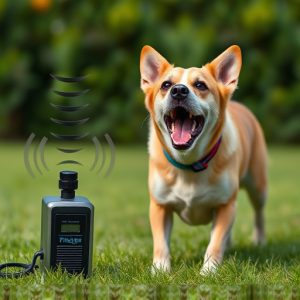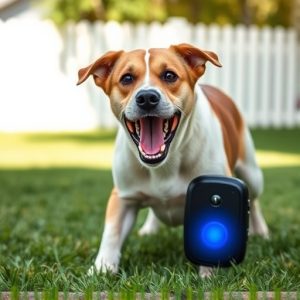Mastering Sonic Dog Training: Effective Use of High-Range Ultrasonic Devices
Sonic dog training uses maximum range ultrasonic dog repellent devices to emit inaudible high-freque…….
Sonic dog training uses maximum range ultrasonic dog repellent devices to emit inaudible high-frequency sounds that disrupt dogs' focus when they exhibit unwanted behaviors, such as barking or jumping. These devices promote better manners without causing harm, with a coverage area of up to 100 square feet. While effective for specific behavioral corrections, they may not address deeper issues requiring professional training. Safe use requires understanding manufacturer guidelines, proper placement, and consistent training methods.
“Explore the transformative power of sonic dog training, a modern behavioral correction method gaining popularity. This innovative approach leverages maximum range ultrasonic dog repellent devices to guide canine behavior without traditional punishment. Our article delves into the principles behind sonic training, how these advanced devices operate, and their proven effectiveness.
We’ll also explore safe use guidelines, ensuring responsible implementation, and consider key factors for prospective dog owners looking to incorporate this game-changing technique.”
- Understanding Sonic Dog Training and Its Principles
- Maximum Range Ultrasonic Dog Repellent Devices: How They Work
- Advantages and Effectiveness of Using These Devices
- Safe Use and Considerations for Sonic Dog Training Correction
Understanding Sonic Dog Training and Its Principles
Sonic dog training, particularly using a maximum range ultrasonic dog repellent device, is a modern approach to behavioral correction that leverages sound waves to modify canine behavior. This method employs high-frequency sounds that are inaudible to humans but can be detected and reacted to by dogs. The principle behind this technique is based on the idea that certain ultrasonic frequencies act as aversives, discouraging unwanted behaviors without causing harm or physical discomfort.
The device emits a specific sound pattern designed to capture the attention of dogs and prompt them to alter their behavior. When a dog exhibits an unwanted action, such as barking excessively or jumping on people, the ultrasonic repellent is activated. The sound disrupts their focus, creating an immediate association between the behavior and the unpleasant sensation caused by the device. Over time, this correction helps train dogs to avoid specific behaviors, promoting better manners and a calmer demeanor.
Maximum Range Ultrasonic Dog Repellent Devices: How They Work
Maximum Range Ultrasonic Dog Repellent Devices use high-frequency sound waves to deter dogs from specific areas without causing them harm. These devices emit sounds in the ultrasonic range, typically between 25 to 64 kHz, which are inaudible to humans but highly irritating to dogs. When a dog approaches the device’s range, they hear a high-pitched squeal that prompts them to leave the area. The maximum range of these devices varies depending on the model and environmental conditions, but some advanced models can cover areas up to 100 square feet or more.
Unlike traditional chemical repellents, which may have strong odors or be difficult to apply, ultrasonic dog repel devices offer a non-toxic, environmentally friendly solution. They are easy to use, portable, and can be activated by motion sensors for automatic operation. However, it’s essential to note that while these devices are effective for specific behavioral corrections like preventing dogs from entering certain areas, they may not address deeper behavioral issues that require professional training or consultation.
Advantages and Effectiveness of Using These Devices
Using a Maximum Range Ultrasonic Dog Repellent Device offers several advantages for effective behavioral correction. Unlike traditional punishment methods, these devices emit high-frequency sound waves that are unpleasant to dogs but harmless to humans and other pets. This non-confrontational approach can be particularly useful for addressing issues like excessive barking, jumping on furniture, or encroaching into restricted areas without resorting to aversive training techniques.
The effectiveness of these devices lies in their ability to condition dogs to avoid certain behaviors. By triggering an unpleasant response when a dog displays unwanted behavior, the device helps reinforce positive alternatives. With consistent use and proper training methods, dogs can learn to associate specific actions with the ultrasonic signal, leading to improved behavior and a calmer home environment for all.
Safe Use and Considerations for Sonic Dog Training Correction
When considering sonic dog training correction, it’s paramount to prioritize safety for both the pet and the user. A maximum range ultrasonic dog repellent device should only be employed as a last resort when traditional training methods have proven ineffective. These devices emit high-frequency sound waves that are unpleasant to dogs but virtually inaudible to humans, making them humane alternatives to physical corrections. However, their safe use requires understanding and adhering to manufacturer guidelines, ensuring proper placement and usage frequency to avoid potential harm or stress to the animal.
Key considerations include selecting a device suitable for your dog’s size and behavior, maintaining consistent training methods, and monitoring your pet’s reaction. It’s crucial not to rely solely on the sonic repellent as a quick fix but instead incorporate it into a comprehensive behavioral correction program involving positive reinforcement, command training, and environmental adjustments. Regular interaction and consultation with a professional trainer or veterinarian can help ensure the device is used responsibly and effectively.
Sonic dog training using maximum range ultrasonic dog repellent devices offers a non-violent, effective solution for behavioral correction. By understanding their principles and safe application, pet owners can harness these tools to create positive habits in their canine companions. While not a one-size-fits-all approach, this method has proven successful for many, providing an alternative to traditional training methods. Remember, proper usage and consideration are key to ensuring a safe and effective experience for both dog and owner.


